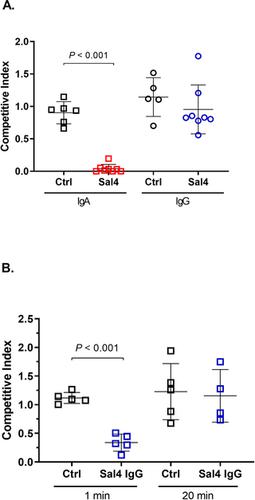当前位置:
X-MOL 学术
›
PLOS Negl. Trop. Dis.
›
论文详情
Our official English website, www.x-mol.net, welcomes your feedback! (Note: you will need to create a separate account there.)
Inhibition of invasive salmonella by orally administered IgA and IgG monoclonal antibodies.
PLOS Neglected Tropical Diseases ( IF 3.8 ) Pub Date : 2020-03-23 , DOI: 10.1371/journal.pntd.0007803 Angelene F Richards 1, 2 , Jennifer E Doering 2 , Shannon A Lozito 2 , John J Varrone 2 , Graham G Willsey 2 , Michael Pauly 3 , Kevin Whaley 3 , Larry Zeitlin 3 , Nicholas J Mantis 1, 2
PLOS Neglected Tropical Diseases ( IF 3.8 ) Pub Date : 2020-03-23 , DOI: 10.1371/journal.pntd.0007803 Angelene F Richards 1, 2 , Jennifer E Doering 2 , Shannon A Lozito 2 , John J Varrone 2 , Graham G Willsey 2 , Michael Pauly 3 , Kevin Whaley 3 , Larry Zeitlin 3 , Nicholas J Mantis 1, 2
Affiliation

|
Non-typhoidal Salmonella enterica strains, including serovar Typhimurium (STm), are an emerging cause of invasive disease among children and the immunocompromised, especially in regions of sub-Saharan Africa. STm invades the intestinal mucosa through Peyer's patch tissues before disseminating systemically. While vaccine development efforts are ongoing, the emergence of multidrug resistant strains of STm affirms the need to seek alternative strategies to protect high-risk individuals from infection. In this report, we investigated the potential of an orally administered O5 serotype-specific IgA monoclonal antibody (mAb), called Sal4, to prevent infection of invasive Salmonella enterica serovar Typhimurium (STm) in mice. Sal4 IgA was delivered to mice prior to or concurrently with STm challenge. Infectivity was measured as bacterial burden in Peyer's patch tissues one day after challenge. Using this model, we defined the minimal amount of Sal4 IgA required to significantly reduce STm uptake into Peyer's patches. The relative efficacy of Sal4 in dimeric and secretory IgA (SIgA) forms was compared. To assess the role of isotype in oral passive immunization, we engineered a recombinant IgG1 mAb carrying the Sal4 variable regions and evaluated its ability to block invasion of STm into epithelial cells in vitro and Peyer's patch tissues. Our results demonstrate the potential of orally administered monoclonal IgA and SIgA, but not IgG, to passively immunize against invasive Salmonella. Nonetheless, the prophylactic window of IgA/SIgA in the mouse was on the order of minutes, underscoring the need to develop formulations to protect mAbs in the gastric environment and to permit sustained release in the small intestine.
中文翻译:

口服IgA和IgG单克隆抗体抑制侵袭性沙门氏菌。
非伤寒性沙门氏菌菌株,包括鼠伤寒沙门氏菌(STm),是儿童和免疫力低下的侵袭性疾病的新兴原因,尤其是在撒哈拉以南非洲地区。STm通过Peyer的斑块组织侵入肠道粘膜,然后进行全身性传播。在疫苗开发工作正在进行的同时,STm多药耐药菌株的出现肯定了需要寻找替代策略来保护高危人群免于感染的需求。在本报告中,我们研究了口服给予O5血清型特异性IgA单克隆抗体(mAb)的潜力,以预防小鼠中侵袭性肠炎沙门氏菌血清鼠伤寒(STm)的感染。在STm攻击之前或同时,将Sal4 IgA递送给小鼠。攻击后一天,将传染性测量为Peyer斑块组织中的细菌负担。使用该模型,我们定义了显着减少Pem斑中STm摄取所需的Sal4 IgA的最小量。比较了Sal4的二聚体和分泌型IgA(SIgA)形式的相对功效。为了评估同种型在口服被动免疫中的作用,我们设计了携带Sal4可变区的重组IgG1 mAb,并评估了其在体外和Peyer斑块组织中阻断STm侵袭上皮细胞的能力。我们的结果证明,口服IgA和SIgA单克隆抗体(而不是IgG)有潜力被动免疫侵袭性沙门氏菌。但是,小鼠中IgA / SIgA的预防窗口约为数分钟,
更新日期:2020-03-24
中文翻译:

口服IgA和IgG单克隆抗体抑制侵袭性沙门氏菌。
非伤寒性沙门氏菌菌株,包括鼠伤寒沙门氏菌(STm),是儿童和免疫力低下的侵袭性疾病的新兴原因,尤其是在撒哈拉以南非洲地区。STm通过Peyer的斑块组织侵入肠道粘膜,然后进行全身性传播。在疫苗开发工作正在进行的同时,STm多药耐药菌株的出现肯定了需要寻找替代策略来保护高危人群免于感染的需求。在本报告中,我们研究了口服给予O5血清型特异性IgA单克隆抗体(mAb)的潜力,以预防小鼠中侵袭性肠炎沙门氏菌血清鼠伤寒(STm)的感染。在STm攻击之前或同时,将Sal4 IgA递送给小鼠。攻击后一天,将传染性测量为Peyer斑块组织中的细菌负担。使用该模型,我们定义了显着减少Pem斑中STm摄取所需的Sal4 IgA的最小量。比较了Sal4的二聚体和分泌型IgA(SIgA)形式的相对功效。为了评估同种型在口服被动免疫中的作用,我们设计了携带Sal4可变区的重组IgG1 mAb,并评估了其在体外和Peyer斑块组织中阻断STm侵袭上皮细胞的能力。我们的结果证明,口服IgA和SIgA单克隆抗体(而不是IgG)有潜力被动免疫侵袭性沙门氏菌。但是,小鼠中IgA / SIgA的预防窗口约为数分钟,



























 京公网安备 11010802027423号
京公网安备 11010802027423号